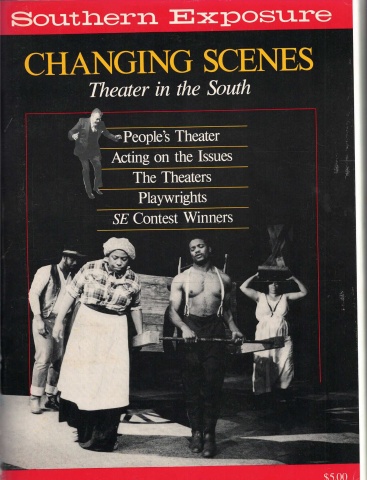
This article originally appeared in Southern Exposure Vol. 14 No. 3/4, "Changing Scenes: Theater in the South." Find more from that issue here.
At first glance, North Carolina's Gaston County prison unit looked like a Boy Scout camp. The dorms and trailers within its cyclone fence might have housed 11-year-olds for a summer of basketball and archery, campfire skits, and arts and crafts. But within these confines of steel and concrete, 106 grown men idled in groups, shooting hoops, pulling on cigarettes, scowling at guards, and heckling the occasional visitor.
Three years ago, when this unit still housed youth offenders aged 16 to 21, volunteer Pat Hall suggested a different approach to pre-release training: a program to enhance communication through dramatic technique and exercises. Inmate theater had been experimented with at other institutions.
"Before you can teach these guys anything, you gotta get them to open up," says Hall, explaining his rationale for developing a prison theater program. A lanky 36-year-old redhead who had spent 19 months in a federal penitentiary, Hall headed the Gaston County unit's Community Release Training program. "When you're in prison you learn to shut yourself off from any feeling, just to survive. The only emotion you can allow is a negative one — to avoid getting beat up, or ripped off, or raped.
"And drama's an excellent way to get them to relax," he continues. "You can get them to smile, laugh, enjoy themselves and others. Creative drama can show them how to share group responsibility, and how to interact as a group."
To put his idea into practice, Hall approached Constance Welsh, artistic director of Taradiddle Players, a repertory theater group in nearby Charlotte. Hall had been her student at the nearby University of North CarolinaCharlotte, where she was developing theater as an educational tool to take on a tour of the state's high schools.
Despite her initial fears, Welsh was surprised that she "encountered no resistance whatsoever" from the inmates on her first day at the prison.
To introduce the inmates to dramatic technique, she began with a simple exercise. "I started by showing them an object — a pack of cigarettes — and asked them who wanted it. From there, we built a drama. Wanting something breeds conflict. We planned a scene with a beginning, middle, and end around this goal. The peer structure was obvious — you'd have a leader; a clown, an egotist. But the nature of the experience in drama is a sublimation of egos to communicate a scene."
Welsh calls the project an immediate success. "In fact, I was a bit overwhelmed. Their hunger for problemsolving, for sharing, was scary. They were very excited."
Welsh coaxed the inmates into performing exercises that taught concentration: "posing as statues, being out in space" — activities "they wouldn't think of doing in another context." But the men did them "because they could see the scenes improve."
The prisoners readily invented dramas about prison life. ''At first I was tempted to shy away from scenes that hit too close to home," recalls Welsh, but "I learned it was foolish to deny the obvious. In fact, they responded best to a story about a lifer, a drug addict who befriended a new inmate, also with a drug problem. The lifer kept trying to tell him to get off the stuff, but it didn't sink in. Until the lifer himself died of an overdose. It was the morality of these scenarios they came up with that was so startling."
Although Hall's and Welsh's project was an experiment, Welsh believes it would have been effective as an ongoing, weekly program. "If [inmates] were offered the classes upon entering prison; if we could have built up scenes into a whole play to wrap up the sessions; if we could have gone the whole works, with props, lighting, costume — so they could have the sense of performing together. They would all gain a sense of cooperation, of achievement, of something positively theirs."
Like many other prison theater projects, this one, too, was destined to be short-lived. The state converted the Gaston unit to an adult prison and dispersed the young offenders to two farflung prisons. Hall comments, "It's darn near impossible to sell a government agency on the validity of doing this." He feels the benefits may be too subtle for bureaucrats to perceive: "You're simply helping an inmate open up after closing off everything and everybody. You give him 30 minutes to escape a negative environment and share something. How do you possibly measure results?"
Tags
Melinda Meschter
Melinda Meschter is a writer and editor in Charlotte, North Carolina. (1986)

